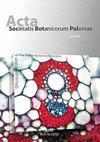标题欧洲乌头亚属的系统发育
IF 0.8
4区 生物学
Q3 PLANT SCIENCES
引用次数: 7
摘要
乌头亚属的系统发育关系。乌头属(毛茛科)在欧洲的分布尚不清楚。为了推测叶绿体DNA (cpDNA)的核(ITS)区和叶绿体基因间间隔区trnL(UAG)-ndhF的系统发育,我们分析了该分类单元的64份材料,其中58份来自欧洲,6份来自高加索,51份来自欧洲,2份来自高加索,其余的序列是独特的。cpDNA序列可分为5个单倍型,即a - e,其中包括一个欧洲-高加索乌头单倍型b。二倍体与四倍体的区别是一个5bp的indel。现存的欧洲二倍体与当地的四倍体类群没有基缘关系。基于ITS和cpDNA序列的系统发育树(贝叶斯推断,最大似然性,最小简约性)将乌头(海阿尔卑斯山脉,中部山脉)和内华达(内华达山脉,比利牛斯山脉)置于所有其他欧洲物种的姐妹群中。一个贝叶斯松弛时钟模型估计高加索人种最早的分裂发生在晚中新世[约70万年前],而A. burnatii和A. nevadense从欧洲遗传种群的分化发生在中新世/上新世(约4.4万年前)。欧洲的二倍体可能是中新世欧洲-高加索植物群的后代,与古代亚洲(第三纪)遗传种群有联系。四倍体的起源仍然不清楚,一些四倍体可能起源于当地,现在已经灭绝的二倍体。在上新世晚期至第四纪,二倍体和四倍体都经历了快速分化。本文章由计算机程序翻译,如有差异,请以英文原文为准。
Phylogeny of Aconitum Subgenus Aconitum in Europe
Phylogenetic relations within Aconitum subgen. Aconitum (Ranunculaceae) in Europe are still unclear. To infer the phylogeny of the nuclear (ITS) region and chloroplast intergenic spacer trnL(UAG)-ndhF of the chloroplast DNA (cpDNA), we analyzed 64 accessions within this taxon, 58 from Europe and six from the Caucasus Mts. Nuclear ITS sequences were identical in 51 European and two Caucasian accessions, whereas the remaining sequences were unique. cpDNA sequences could be categorized into five haplotypes, i.e., A–E, including a European-Caucasian Aconitum haplotype B. Ten cpDNA sequences were unique. A 5-bp indel distinguished the diploids from the tetraploids. None of the extant European diploids were basal to the tetraploid local group. A phylogenetic tree based on combined ITS and cpDNA sequences (bayesian inference, maximum likelihood, minimal parsimony) placed Aconitum burnatii (Maritime Alps, Massif Central) and A. nevadense (Sierra Nevada, Pyrenees) in a sister group to all other European species. A Bayesian relaxed clock model estimated the earliest split of the Caucasian species during the Late Miocene [ca. 7 million years ago (Mya)], and the divergence of A. burnatii and A. nevadense from the European genetic stock during the Miocene/Pliocene (ca. 4.4 Mya). Diploids in Europe are likely to be descendants of the Miocene European-Caucasian flora linked with the ancient Asian (arctiotertiary) genetic stock. The origins of the tetraploids remain unclear, and it is possible that some tetraploids originated from local, now extinct diploids. Both the diploids and tetraploids underwent rapid differentiation in the Late Pliocene – Quaternary period.
求助全文
通过发布文献求助,成功后即可免费获取论文全文。
去求助
来源期刊
CiteScore
2.00
自引率
10.00%
发文量
18
审稿时长
1 months
期刊介绍:
The journal has been published since 1923 and offers Open Access publication of original research papers, short communications, and reviews in all areas of plant science, including evolution, ecology, genetics, plant structure and development, physiology and biochemistry.

 求助内容:
求助内容: 应助结果提醒方式:
应助结果提醒方式:


